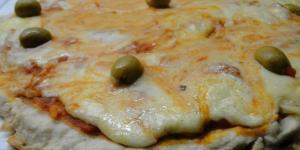Difference Between Pinsa Romana and Pizza


Many cities in the US argue over whether their pizza is the best. For example, the heated debates between New York style pizza by the slice and deep-dish pizza from Chicago can get emotional. Unfortunately, neither of these cities are in Italy, where pizza originates. While it is impossible to confirm the exact origin of pizza, it is generally accepted that it originates in the Campanian city of Naples. This provides the classic pizza napoletana which constitutes the classic round dish with minimal toppings. While it is considered the original, other types of Italian pizza have emerged with key differences. One recent development is a dish called pinsa. oneHOWTO provides a comparison and recipes as we look at the difference between pinsa romana and pizza.
What is pizza napoletana?
One of the most popular dishes in the world, Neapolitan pizza is hard to beat. Its origins are in Naples, a city on the Campanian coast in Italy. Its main characteristics are a thin dough with airy edges, the result of quick cooking. Real traditional pizza napoletana is cooked in a very hot oven, only requiring two to three minutes to bake it perfectly. It should be in a wood-fired oven at extremely high temperatures (around 840ºF/450ºC).
The basic ingredients of traditional pizza napoletana are wheat flour, water, salt, yeast and, in some cases, a splash of olive oil. These fresh products make this dough irresistible, crispy and very tasty. A multitude of ingredients can be added to the base, although the most traditional Neapolitan pizza is the Margherita, with a tomato base, mozzarella and basil. The Marinara is prepared with tomato, garlic, oregano and olive oil.
Authentic Italian pizza has undoubtedly won over millions of palates thanks to its preparation, with a pizza dough fermented for between 8 and 24 hours. The quality of the fresh ingredients used to complete it also make all the difference. Since it's one of the country's most exported dishes, a multitude of versions and varieties of Italian pizza exist. However, many of these are far from the beautiful simplicity of true pizza napoletana.
Traditional pizza napoletana recipe
- Dissolve 1.5 g of dry yeast in warm water and let it rest for 5 minutes.
- In a bowl, add 150 g of tipo 00 flour, along with 3.5g of salt. You can use another flour substitute, as long as it is strong flour.
- Add the water with the yeast to the mixture and a tablespoon of extra virgin olive oil.
- Knead the ingredients for 10 to 15 minutes or until you obtain a smooth, elastic and homogeneous dough.
- Form the dough into a ball, cover it and let it proof for a few hours until it doubles in size.
- When the proofing is complete, roll out the dough on a lightly floured surface, shaping it into a circle about 10-12" (25-30 cm) in diameter.
- If you don't have a stone oven, preheat your oven to the maximum temperature (minimum 480ºF/250ºC).
- Cover the base with tomato and bake for 6 to 8 minutes, or less time if you have a hotter oven.
- Next, add your favorite toppings. Add mozzarella and basil for a margherita and bake for 2 to 4 more minutes, until the cheese is melted and the crust is golden.
- Cut it into portions and enjoy this Neapolitan delight.
If you have certain dietary requirements, you may want to learn how to make unleavened pizza dough.

What is pinsa romana?
Although the Roman pinsa is less popular than traditional Neapolitan pizza, it is also an ancient Italian bread dish. Its recent popularity is a food trend which has resurrected it in the collective consciousness, but has never actually gone away. It originates in the Lazio region, but it is most associated with Rome. The name pinsa comes from the Latin pinsere, which means to ‘flatten’ or ‘spread’, relating to how the dough is prepared-
Pinsa is made by mixing primarily wheat, rice and soy flours, providing the dough with a softer and airier texture. It also has a lower gluten content. It requires a more prolonged fermentation of between 48 and 72 hours. This both enhances its flavor and can help aid digestion. The result is a dough very similar to pizza, but much lighter than traditional Italian pizza.
The pinsa romana is characterized by its oval or rectangular shape, crispy edges and alveolated base. These alveolar shapes create small air holes to give this dish a lighter texture. You can use any fresh ingredients you like for toppings, although the most popular combination is arugula, prosciutto and burrata.
Basic recipe:
- Mix 300 g of flour (60% wheat, 20% rice and 20% soy) with 2 g of dried yeast in a bowl.
- Add 240ml of water little by little while continuing to mix.
- Add 10ml of extra virgin olive oil and 5g of salt to the mixture and continue stirring.
- Knead until you obtain a homogeneous dough with the ingredients completely integrated.
- Form the dough into a ball and let it ferment in the refrigerator for 48 to 72 hours.
- Take the dough out 1 hour before using it, divide it into portions and stretch it into an oval shape.
- Preheat the oven to 480ºF/250ºC for 5 minutes.
- Add toppings of your choice, such as prosciutto or burrata.
- Bake the pinsa for 7 to 10 minutes.
- When it's golden brown, you can take it out of the oven and enjoy its delicious flavor.
If you are unsure about baking conditions, take a look at our guide on when to use a fan oven.

Main differences between pizza and pinsa romana
Both are baked and share similar ingredients, yet pizza napoletana and pinsa romana are two different dishes. These differences can be seen in composition, preparation, texture, flavor and even origin. Below, we discover the main differences between classic pizza and pinsa romana.
Origin
Although both originate in Italy, pizza and pinsa have different origins. Traditional pizza originates in Naples, being a staple dish of Neapolitan cuisine. It was declared an Intangible Cultural Heritage of Humanity by UNESCO in 2017. Pinsa originates in Ancient Rome, specifically in the Lazio region. The recipe was revived in 2000 to adapt it to modern times and offer a modern version of this delicacy.
Composition
Another important difference is the composition. While pizza requires type 00 wheat flour (a highly refined flour) to obtain an elastic and resistant dough, pinsa uses a blend of three types of flour. These are wheat, rice and soy. This is a lighter combination with less gluten and results in a more airy dough.
Preparation and fermentation
In the preparation and fermentation of both products, we can also observe notable differences. Traditional pizza requires a hydration level of between 60% and 65% for a much denser and easier-to-work dough. In contrast, the hydration level of pinsa is much higher at around 80%. This results in a moister and lighter dough.
The hydration level also determines digestibility. Essentially, the higher the hydration, the easier it is to digest. Similarly, we can see differences in fermentation. While pizza's fermentation time ranges from 8 to 24 hours, pinsa requires a much longer. Pinsa uses cold fermentation for between 48 and 72 hours, substantially reducing the gluten content and improves the texture of the dough. Overall, this makes pins amuch lighter.
Cooking
There are also some differences in the cooking process between the two recipes. As we've noted, pizza is usually cooked in a wood-fired or stone oven at very high temperatures. Is cooking time is very short, just one or two minutes. In the case of the pinsa, it is usually cooked in an electric or stone oven at a slightly lower temperature. This means it takes longer, usually between 8 and 12 minutes.
Texture
Another aspect that differentiates the two dishes is their texture. While pizza napoletana is characterized by a thin crust with puffy edges and a more chewy texture when chilled, pinsa has a crispy outside and a soft inside. This is due to the longer fermentation of the latter which provides a lighter and more airy crumb.
Shape
The presentation of pizza and pinsa also differs. Traditional pizza is usually round and is served whole or in slices. It can sometimes be eaten folded as street food, but it is typically eaten with a knife and fork in italy. As for the pinsa, its shape is more oval or elongated, making it easier to cook. Its presentation is much more rustic and pinsa romana is designed to be shared.
Digestibility
Digestibility is also a notable difference between pizza and pinsa. In fact, pinsa is considered healthier and easier to digest. This is due to its blend of flours, high hydration content and long fermentation. Pinsa is also better for people with gluten sensitivity or intolerance, but it is not to be eaten for people with celiac disease as it does contain some gluten. Although Neapolitan pizza it is quite easy to digest, it can be heavier given that it uses refined flours. Its short fermentation to make its dough and gluten content also affect digestion.
If you have celiac disease, you may want to know does quinoa contain gluten?
Popularity
Finally, there are also obvious differences in popularity and distribution. Classic Italian pizza is highly regarded and present almost everywhere in the world. It offers countless versions and variations, from the traditional Neapolitan to more loaded American versions.
The Roman pinsa is less well-known internationally. In fact, this legendary recipe has recently been rediscovered in Italy, its country of origin. It is currently regaining popularity and undergoing a modernization. Likewise, some European countries are also promoting the pinsa as a gourmet and healthier alternative to traditional pizza.
To learn some more background information on baking, check out our article explaining what is the difference between self-raising flour and plain flour?
If you want to read similar articles to Difference Between Pinsa Romana and Pizza, we recommend you visit our Recipes category.






